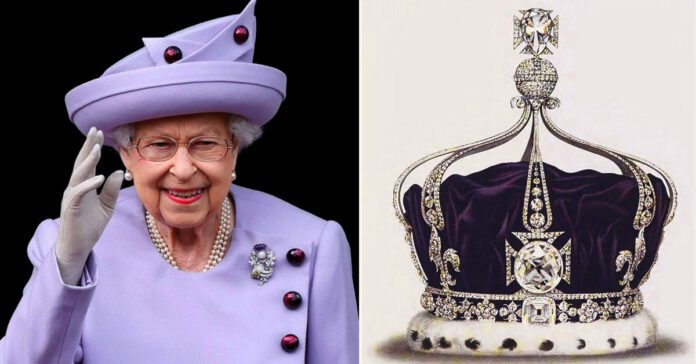Recently, following the death of British monarch Queen Elizabeth II, demand to bring the diamond Koh-i-Noor back to India gained momentum. In this account of Avaaz24, we shall know more about the diamond Koh-i-Noor and how it landed in the hands of British.
What is Koh-i-Noor?
It is one of the most expensive diamonds of the world. Currently, it is a part of British Crown Jewels. The word Koh -i- Noor is of Persian origin, meaning Mountain of Light [Koh~ Mountain; Noor~ Light]. Originally it weighed 191.10 Carats. But it was re-cut
in 1852 at London. It lost 43% of its original weight in the process. Today it weighs 108.93 Carats.
Where was Koh-i-Noor excavated from?
During the period of Kakatiyas, this Diamond was excavated in Kolar mines on the right bank of river Krishna in Karnataka.
According to few historians, it was found in Golconda mines of Andhra Pradesh on the bed of Godavari River. Either Kolar or Golconda mines, both belong to Kakatiyas.
Some attribute it to hills of Amaravati in Maharashtra.
Is Koh-i-noor the largest diamond in the world?
No. Cullinan Diamond discovered in Premier mine in South Africa in 1905 is the world’s biggest diamond. Named after Thomas Cullinan, the owner of the mine, it weights 3106 carats. The government of Transvaal, gifted Cullinan to King Edward VII of England as a pledge of loyalty.
History: How it landed in Britain?
Koh-i-Noor diamond was never bought or sold. It always changed hands as a result of conquest.
Before 1526 AD: the lost history
The historical evidence of Koh-i-Noor gem started only from the year 1526 AD. This legendary gem is mentioned in Mughal emperor Babur’s memoir “Baburnama”.
Ala-ud-din Khalji of Delhi Sultanate invaded and looted the Kakatiyas in the beginning of 14th century. Reportedly, he took over the Koh-i-Noor from them.
1526-1544 AD: Koh-i-Noor with Mughals
Babur defeated not only Ibrahim Lodi in the first Battle of Panipat in 1526 AD, but also Raja Vikramaditya of Gwalior. Following the defeat, their captured families were permitted to leave by Prince Humayun.
Then, the family of Late Raja of Gwalior made voluntary offering of a mass of jewels to Humayun which included Koh-i-Noor diamond. How the gem reached to Raja of Gwalior from Ala-ud-din Khalji is not known.
1544-1547 AD: Koh-i-Noor with Persians
When Humayun lost Battle of Bilgram against Shershah Suri he fled to Persia. There, the Persian ruler Shah Tahmasp cordially received Humayun as a refugee. Thus, Humayun gave Koh-i-Noor to Shah Tahmasp as a token of his gratitude. From 1544-1547, it remained in Iran.
1547-1656 AD: Koh-i-Noor with Shia Muslim Sultanates of Deccan
Being harassed by Sunni Muslim Emperor of Delhi, the Shia Muslim Sultanates of Deccan- Ahmednagar, Golkonda and Bijapur regarded King of Persia as their religious head.
Shah Tahmasp of Persia (Iran) sent presents to Burhan Nizam Shah of Ahmednagar (Deccan) (present Maharastra) – which included Koh-i-Noor. Thus the precious Koh-i-Noor remained in possession of Nizam Shahis of Ahmednagar and Qutb Shahis of Golconda for next 109years i.e. from 1547-1656 AD.
1656-1739 AD: Koh-i-Noor again with Mughals
On July 18, 1656, Mir Jhumla Ex Prime Minister of Sultan Abdulla Qutb Shah of Golconda presented the Koh-i-Noor to Mughal Emperor Shah Jahan. This event was recorded by William Jessop, an agent of East India Company.
After Shah Jahan, Aurangzeb got hold of this priced possession. During this time, the famous French diamond merchant and traveler, Jean Baptiste Tavernier had a chance of seeing and examining this peerless stone.
After Aurangzeb this diamond remained in Mughal treasury till 1739 AD. The Mughal emperor Muhammad Shah Rangeela used to carry this diamond in his turban.
1739- 1747 AD: Koh-i-Noor again with Persians
The Persian Nadir Shah defeated Mughal Muhammad Shah Rangeela in Battle of Karnal and occupied fort of Delhi on March 9, 1739. Knowing that Muhammad Shah hid Koh-i-Noor in his turban, tricked him to exchange the turban as a sign of friendship in Durban Hall.
Because of this “Turban Trick” Nadir Shah could get Koh-i-Noor in his possession till his death in 1747 AD.
1749-1813 AD: Koh-i-Noor with Afghans
On June 8, 1747 AD Nadir Shah was killed by Muhammad Quli Khan of Persia at Fatehbad near Mashhad. Afterwards, his Afghan General Ahmad Shah Abdali (Durrani) stole the diamond Koh-i-Noor from his master.
After Durrani’s death, his son Timur Shah took it. After Timur, his son Zaman Shah took it over, followed by his youngest son Shah Shuja-ul-mulk.
Shuja’s half brother, Mahummud defeated him and handed over him as a prisoner to Ata Muhammad Khan, Governor of Kashmir. At that time, Koh-i-Noor was in possession of Shuja’s queen Wafa Begum.
1813-1849 AD: Koh-i-Noor with Sikhs
On request of Wafa Begum, Maharaja Ranjith Singh of Punjab secured the release of Shah Shuja-ul-mulk. With gratitude, in exchange the couple handed Koh-i-Noor to Maharaja Ranjith Singh.
After Ranjith Singh, his successors retained the diamond during their rule.
1849-1999 AD and after: Koh-i-Noor with British
The last Indian Sovereign to possess Koh-i-Noor was 11 year old Maharaja Duleep Singh. On March 29, 1849 under the Treaty of Lahore, Sikh kingdom got annexed into British India. Following that, Duleep Singh was deposed.
He surrendered all his fortunes including Koh-i-Noor, Daryanoor and Timur’s Ruby to Queen of England as per the treaty.
The then Governor General of India Dalhousie officially received the gem on December 7,1849.
The Kohinoor left Indian shores on April 6, 1850. Upon reaching London on July 2, 1850, Sir J.W. Logg Deputy Chairman of East India Company presented it to Queen Victoria on July 3, 1850 at Buckingham Palace.
Since its acquisition by Queen Victoria, Koh-i-Noor is in possession of British Royalty.
Who are its actual owners?
Today, governments of India, Pakistan, Iran and Afghanistan, all are claiming ownership on Kohinoor and are demanding its return. But the British Government says, they got the gem legally under the terms of Treaty of Lahore. Hence they reject the claims of all the above countries.
If one day, Koh-i-Noor is to return to its home country, it should reach India. Tracing its history, to begin with it is related to Kakatiyas of Deccan.





